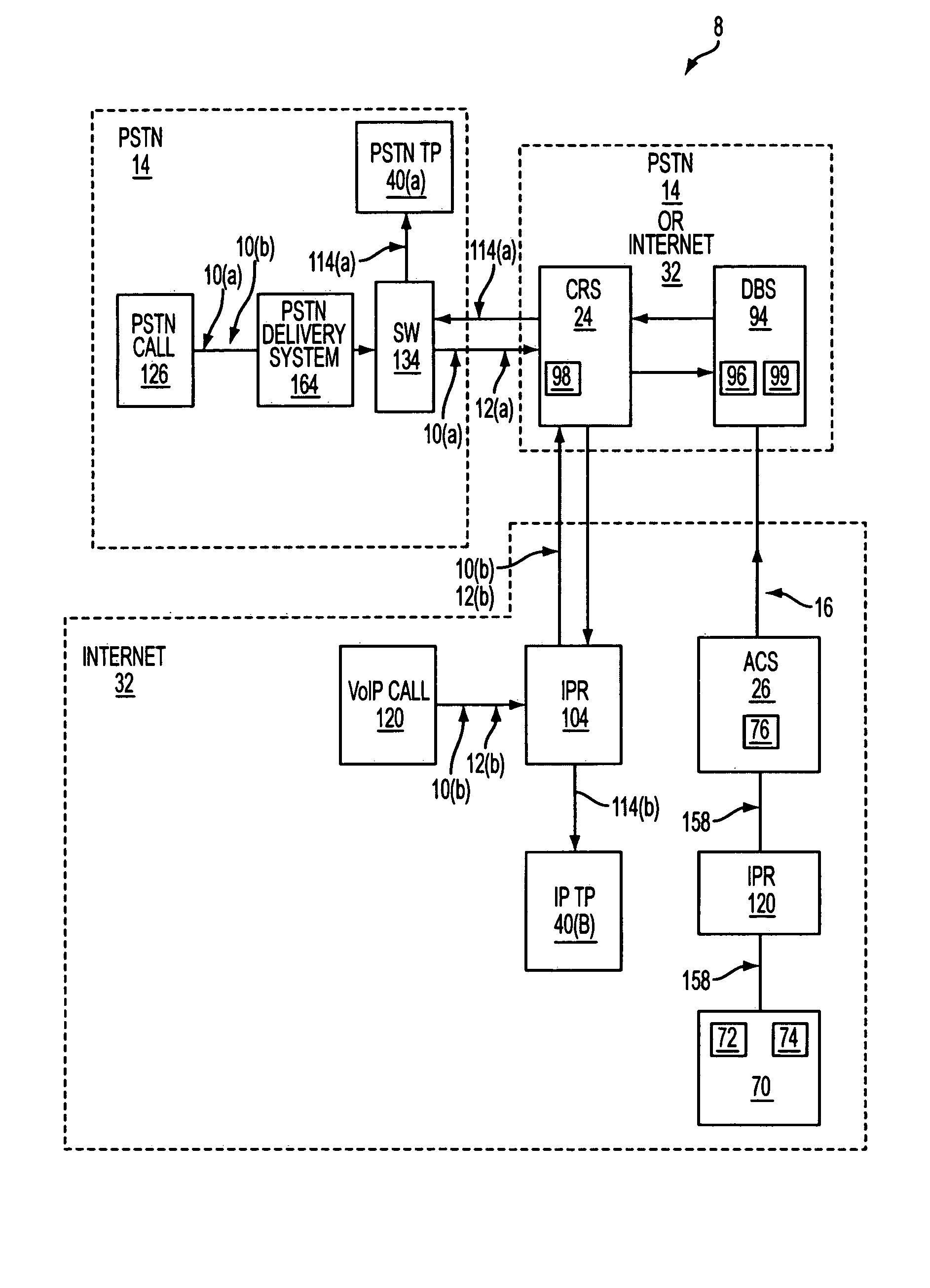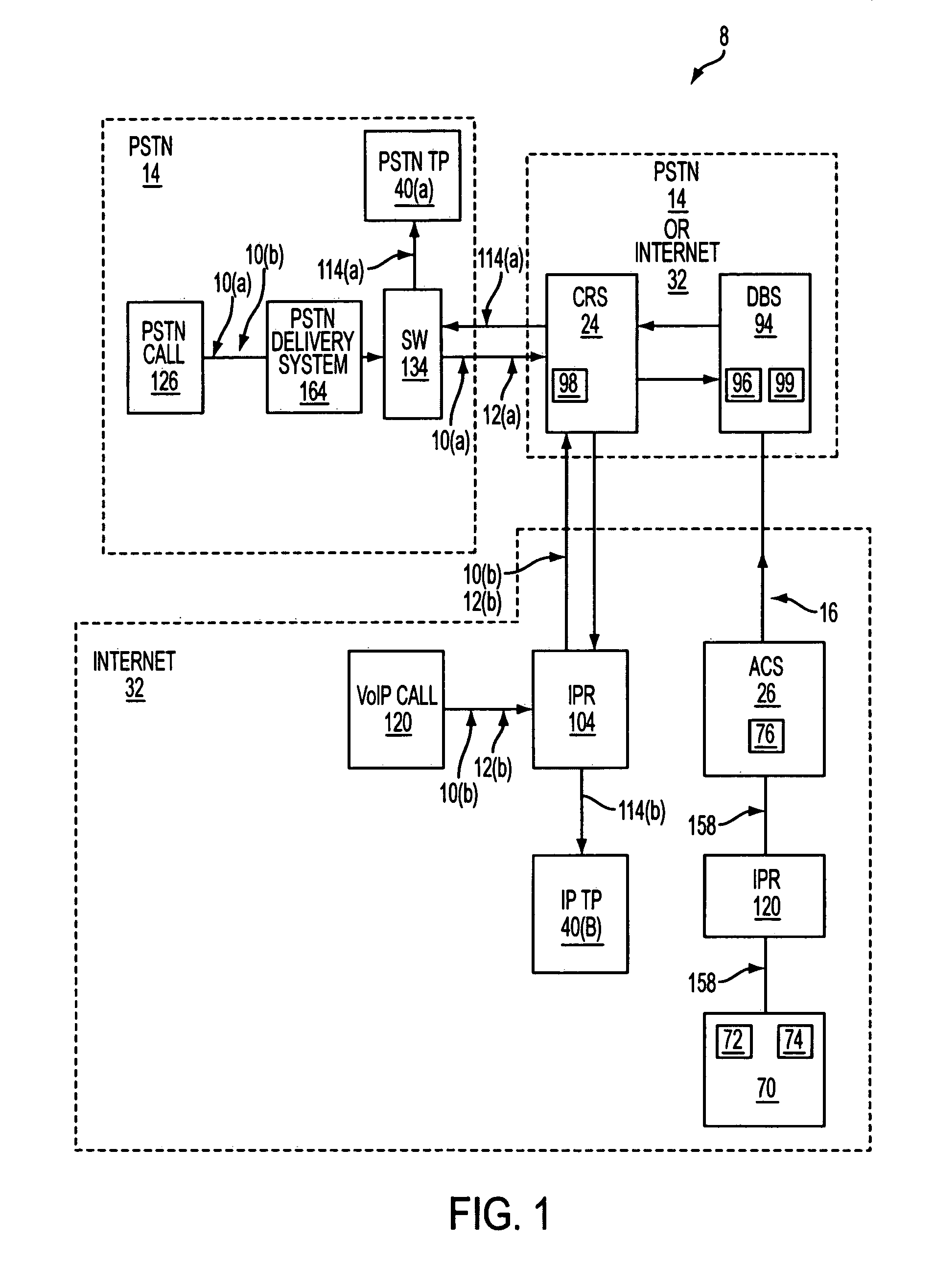[0008]Our invention relates to a method to give a subscriber control over his or her telephone at the subscriber's fingertips through the use of access codes that are distributed to callers. The incoming telephone call may be one made over the “regular”
telephone network (the Public Switched
Telephone Network) or
the Internet. Our invention uses two networks, the public-switched
telephone network and
the Internet. These two networks are interlinked using an Internet gateway. The marriage of the two networks provides for an unprecedented ability to put control into the hands of the subscriber. Our invention allows the subscriber to dictate how a call is to be routed to the subscriber based on the access code input by the subscriber. This information is input using the Internet, empowering the subscriber with greater control and ease of use.
[0014]Using one's computer at home, a modem and a
web browser, the subscriber accesses the Access Code Server over the Internet and inputs access code information.
Interfacing with a
web page, the subscriber enters access code numbers followed by entries indicating the manner of call treatment for each access code. Using the
web page, the subscriber selects the services (i.e., the telephonic peripherals to be made available to the caller) that the subscriber wants and determines how each access caller is treated and inputs this data on the Access Code Server. The telephonic
system is also capable of allowing the subscriber to select how callers without access codes are treated. The telephonic
system is programmable to allow routing either generally without regard to the location that the call is being placed, or based upon the CLID of an incoming PSTN telephone call or the
IP address of the incoming VoIP telephone call.
[0021]This invention exploits the creative potential of the Internet and employs it in the telephonic environment. Today's Web browsers provide a
user friendly environment to use the Internet.
The Internet puts the development of information into the hands of subscribers themselves.
The Internet represents a unique opportunity to allow the telephone subscriber to control his or her telephone with great ease. The ACS is a
Web server which sends a
control signal over an Internet to the PSTN call-
router. The ACS is a gateway that bridges the public telephonic network with Internet. The subscriber conveniently inputs how the subscriber's telephone is to be used, by using a computer that may be at the subscriber's home or office. The subscriber accesses the Internet using a modem and a
Web browser, and enters the URL (
Uniform Resource Locator, more colloquially known as the “web address”) of the
web site located on a
Web server that is functioning as the Access Code Server. After accessing the
web site, the subscriber can easily alter how each call is handled based on access code to facilitate Access Code Routing. CLID Routing could also be implemented, as could Access Code Routing overriding CLID Routing.
[0022]This invention is specifically implemented to provide
public access (access from the public
telephone network) to a private phone line. The subscriber decides who has access to his phone by distributing access codes. The subscriber could time-stamp the access codes to the private phone line (or for that matter, any of the other telephonic peripherals) so that the private phone line would only be valid for certain time periods. At subscriber's wish, certain callers would have access only during certain times of the day, or a certain period of days, etc. The subscriber may change the access codes that enable a particular caller to access the private phone line. This has the effect of having an unlisted
telephone number that constantly can be changed with respect to any one or group of particular callers.
[0024]Our invention transcends Virtual Number Portability in that the calls could be divided up as members of a household (or business) move. Thus, there is Individual Virtual Number Portability. Suppose that four people-father, mother, son and
daughter-live in Seattle. Further suppose father and mother move to Florida to retire, and son goes to college in New York City and
daughter goes to college in Boston. The Access Code Server could easily be programmed so that callers who have the parents' access code are forwarded to their home in Florida; the callers who have the son's code are forwarded to New York; and the callers that who have the
daughter's code are directed to the daughter's phone in Boston. Particular callers could also be given multiple access codes and told which access codes will reach what parties. Thus, someone could easily be enabled to call the mother and father, the son and the daughter by simply knowing the original telephone number and the access codes. No matter how many times the children change dorm rooms, or the parents move around the world to sightsee, these numbers would remain valid. This would obviate the necessity of the four to contact all their friends, relatives and business acquittances and tell them of their new phone number.
 Login to View More
Login to View More  Login to View More
Login to View More 


